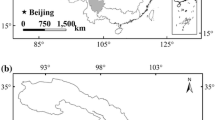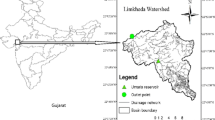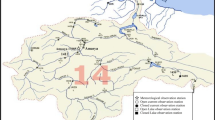Abstract
In semi-arid watersheds, hydrological drought is manifested by reasonably low streamflow conditions. This makes streamflow forecasting as an inevitable component for implementing drought management practices. Data-driven modelling techniques are often applied for simulating the streamflow forecasts. In this study, a comparison between conventional feedforward neural network (FFNN) model and wavelet enabled artificial neural network (WANN) model is carried out to analyse their effectiveness in streamflow forecasting. The input data used to develop and simulate the models are monthly precipitation, and monthly river stage of twenty-five years (January 1991 to December 2015). Data pre-processing is carried out using correlation analysis prior to neural network modelling for selecting appropriate input combinations. The preprocessed data is directly given as input for FFNN; whereas for WANN, the preprocessed time series datasets are decomposed into several sub-series and are used as the inputs. Analysis on three different transfer functions that are commonly used in ANN models is carried out to identify the best transfer function. Hyperbolic tangent sigmoid transfer function is found to be best suitable for modelling streamflow forecasts. The result also shows that there is a significant improvement in streamflow forecasting ability for WANN models compared to FFNN. Drought forecasting is carried out by developing a standardized streamflow index from the forecasted streamflow. The drought forecasting technique discussed here will help planners to make informed decisions on watershed management and drought mitigation measures.









Similar content being viewed by others
References
Adamowski, J. (2008). Development of a short-term river flood forecasting method for snowmelt driven floods based on wavelet and cross-wavelet analysis. Journal of Hydrology, 353(3–4), 247–266.
Alizadeh, M. J., & Kavianpour, M. R. (2015). Development of wavelet-ANN models to predict water quality parameters in Hilo Bay, Pacific Ocean. Marine Pollution Bulletin, 98(1), 171–178.
Anctil, F., & Tape, D. G. (2004). An exploration of artificial neural network rainfall-runoff forecasting combined with wavelet decomposition. Journal of Environmental Engineering and Science, NRC Research Press Ottawa, Canada, 3(Supplement 1), S121–S128.
ASCE. (2000). Artificial neural networks in hydrology. II: Hydrologic applications. Journal of Hydrologic Engineering, 5(2), 124–137.
Aussem, A., Campbell, J., & Murtagh, F. (1998). Wavelet-based feature extraction and decomposition strategies for financial forecasting. Journal of Computational Intelligence in Finance, 6(2), 5–12.
Barua, S., Ng, A. W. M., & Perera, B. J. C. (2012). Artificial neural network-based drought forecasting using a nonlinear aggregated drought index. Journal of Hydrologic Engineering, 17(12), 1408–1413.
Cannas, B., Fanni, A., See, L., & Sias, G. (2006). Data preprocessing for river flow forecasting using neural networks: Wavelet transforms and data partitioning. Physics and Chemistry of the Earth, Parts A/B/C, 31(18), 1164–1171.
Castellano-Méndez, M., González-Manteiga, W., Febrero-Bande, M., Prada-Sánchez, J. M., & Lozano-Calderón, R. (2004). Modelling of the monthly and daily behaviour of the runoff of the Xallas river using Box-Jenkins and neural networks methods. Journal of Hydrology, Elsevier, 296(1), 38–58.
Chiang, Y., Chang, L., & Chang, F. (2004). Comparison of static-feedforward and dynamic-feedback neural networks for rainfall–runoff modeling. Journal of Hydrology, 290(3–4), 297–311.
Dawson, C., & Wilby, R. (1999). A comparison of artificial neural networks used for river forecasting. Hydrology and Earth System, 3, 529–540.
Drisya, J., Sathish Kumar, D. (2016). Comparison of digitally delineated stream networks from different space borne digital elevation models: A case study based on two watersheds in South India. Arabian Journal of Geosciences. https://doi.org/10.1007/s12517-016-2726-x.
Govindaraju, R. (2000). Artificial neural networks in hydrology. II: Hydrologic applications. Journal of Hydrologic Engineering, 5(2), 124.
Karul, C., Soyupak, S., Çilesiz, A. F., Akbay, N., & Germen, E. (2000). Case studies on the use of neural networks in eutrophication modeling. Ecological Modelling, 134(2), 145–152.
Keyantash, J. A., & Dracup, J. A. (2004). An aggregate drought index: Assessing drought severity based on fluctuations in the hydrologic cycle and surface water storage. Water Resources Research. https://doi.org/10.1029/2003WR002610.
Kim, T.-W., & Valdés, J. B. (2003). Nonlinear model for drought forecasting based on a conjunction of wavelet transforms and neural networks. Journal of Hydrologic Engineering, 8(6), 319–328.
Kişi, Ö. (2004). River flow modeling using artificial neural networks. Journal of Hydrologic Engineering, 9(1), 60–63.
Kişi, Ö. (2008). Stream flow forecasting using neuro-wavelet technique. Hydrological Processes, 22(20), 4142–4152.
Minu, K. K., Lineesh, M. C., & John, C. J. (2010). Wavelet neural networks for nonlinear time series analysis. Applied Mathematical Sciences, 4(50), 2485–2495.
Mishra, A. K., & Desai, V. R. (2006). Drought forecasting using feed-forward recursive neural network. Ecological Modelling, 198(1–2), 127–138.
Mishra, A., Desai, V., & Singh, V. (2007). Drought forecasting using a hybrid stochastic and neural network model. Journal of Hydrologic Engineering, 12(6), 626–638.
Modarres, R. (2007). Streamflow drought time series forecasting. Stochastic Environmental Research and Risk Assessment, Springer-Verlag, 21(3), 223–233.
Morid, S., Smakhtin, V., & Bagherzadeh, K. (2007). Drought forecasting using artificial neural networks and time series of drought indices. International Journal of Climatology, Wiley Online Library, 27(15), 2103–2111.
Nayak, P. C., Venkatesh, B., Krishna, B., & Jain, S. K. (2013). Rainfall-runoff modeling using conceptual, data driven, and wavelet based computing approach. Journal of Hydrology, Elsevier, 493, 57–67.
Nourani, V., Komasi, M., & Mano, A. (2009). A multivariate ANN-wavelet approach for rainfall–runoff modeling. Water resources management, Springer, 23(14), 2877–2894.
Nury, A. H., Hasan, K., & Alam, M. J. B. (2017). Comparative study of wavelet-ARIMA and wavelet-ANN models for temperature time series data in northeastern Bangladesh. Journal of King Saud University - Science, 29(1), 47–61.
Partal, T., & Kişi, Ö. (2007). Wavelet and neuro-fuzzy conjunction model for precipitation forecasting. Journal of Hydrology, Elsevier, 342(1), 199–212.
Patil, A. P., & Deka, P. C. (2017). Performance evaluation of hybrid Wavelet-ANN and Wavelet-ANFIS models for estimating evapotranspiration in arid regions of India. Neural Computing and Applications, 28(2), 275–285.
RStudio. (2017). RStudio: Integrated development environment for R. R version.
Saadat, S., Khalili, D., Kamgar-Haghighi, A. A., & Zand-Parsa, S. (2013). Investigation of spatio-temporal patterns of seasonal streamflow droughts in a semi-arid region. Natural Hazards, 69(3), 1697–1720.
Seo, Y., Kim, S., Kisi, O., & Singh, V. P. (2015). Daily water level forecasting using wavelet decomposition and artificial intelligence techniques. Journal of Hydrology, 520, 224–243.
Sudheer, K. P., Gosain, A. K., & Ramasastri, K. S. (2002). A data-driven algorithm for constructing artificial neural network rainfall-runoff models. Hydrological Processes, 16(6), 1325–1330.
Tayyab, M., Zhou, J., Adnan, R., & Zeng, X. (2017). Application of artificial intelligence method coupled with discrete wavelet transform method. Procedia Computer Science, 107, 212–217.
Tokar, A., & Johnson, P. (1999). Rainfall-runoff modeling using artificial neural networks. Journal of Hydrologic Engineering, 4(3), 232–239.
Vicente-Serrano, S. M., López-Moreno, J. I., Beguería, S., Lorenzo-Lacruz, J., Azorin-Molina, C., & Morán-Tejeda, E. (2012). Accurate computation of a streamflow drought index. Journal of Hydrologic Engineering, 17(2), 318–332.
Wang, W., & Ding, J. (2003). Wavelet network model and its application to the prediction of hydrology. Nature and Science, 1(1), 67.
Wang, W., Jin, J., & Li, Y. (2009). Prediction of inflow at three gorges dam in Yangtze river with wavelet network model. Water Resource Management, 23, 2791–2803. https://doi.org/10.1007/s11269-009-9409-2.
Wilhite, D. A. (1993). Drought assessment, management, and planning: Theory and case studies. New York: Springer.
Wu, C., Chau, K., & Li, Y. (2009). Methods to improve neural network performance in daily flows prediction. Journal of Hydrology, 372(1–4), 80–93.
Zealand, C., Burn, D., & Simonovic, S. (1999). Short term streamflow forecasting using artificial neural networks. Journal of Hydrology, 214(1–4), 32–48.
Acknowledgements
The INSPIRE component of Department of Science and Technology, Govt. of India is specially acknowledged for the financial support provided as research fellowship grant for the present study (Grant No. IF131103). The authors would like to extend the gratitude towards the respective Govt. agencies and Engineers who provide data for the analysis.
Author information
Authors and Affiliations
Corresponding author
Additional information
Publisher's Note
Springer Nature remains neutral with regard to jurisdictional claims in published maps and institutional affiliations.
Rights and permissions
About this article
Cite this article
Drisya, J., Kumar, D.S. & Roshni, T. Hydrological drought assessment through streamflow forecasting using wavelet enabled artificial neural networks. Environ Dev Sustain 23, 3653–3672 (2021). https://doi.org/10.1007/s10668-020-00737-7
Received:
Accepted:
Published:
Issue Date:
DOI: https://doi.org/10.1007/s10668-020-00737-7




